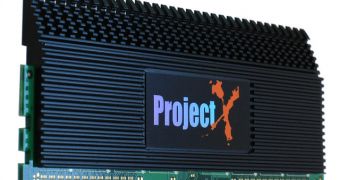Super Talent Technology announced that its recent line of high end DDR3 Project X memory modules are now officially supporting the Intel Extreme Memory Profiles, XMP for short, that allows the new generation of computer systems to scale the latencies of the memory sub-system according to the workload.
The great news is that all memory modules that were recently launched under the Project X designation are offering XMP support, as Joe James, Super Talent Marketing Director, said and was cited by the news site xbitlabs. ''Project X was designed to support XMP from the very start, so every Project X kit we've ever shipped already supports XMP. We're very happy to bring new performance enhancing features like XMP to market through our partnership with Intel. XMP replaces the pain of tweaking every individual memory parameter with the simplicity of selecting a single performance profile to optimize memory timings.''
The XMP technology was developed by Intel in collaboration with mainboard and memory manufacturing companies and it uses a previously reserved sector from the Serial Presence Detect (SPD for short) chip which is found on all memory modules in order to store a number of pre-configured profiles regarding the latency settings of that particular memory module. Thanks to this new technology, it is now easier for users to overclock their computer systems based on Intel P35 and X38 chipsets.
Project X is the general designation of Super Talent's own high-end memory modules and they now come with XMP capabilities as well. The manufacturing company promises aggressive latency timings for these products and they are right on the spot as their latest memories reach a clock frequency of 1800MHz while operating at 7-7-7-21 timings in conjunction with a 2.0V voltage setting.
Apart from the DDR3 PC3-14400 memory modules, Super Talent also offers modules that are clocked at 1600MHz while using the lower 7-6-6-18 latencies and 1.8V setting and both of these new memories are XMP-enabled, so overclocking a computer system that integrates them will be a piece of cake.

 14 DAY TRIAL //
14 DAY TRIAL //